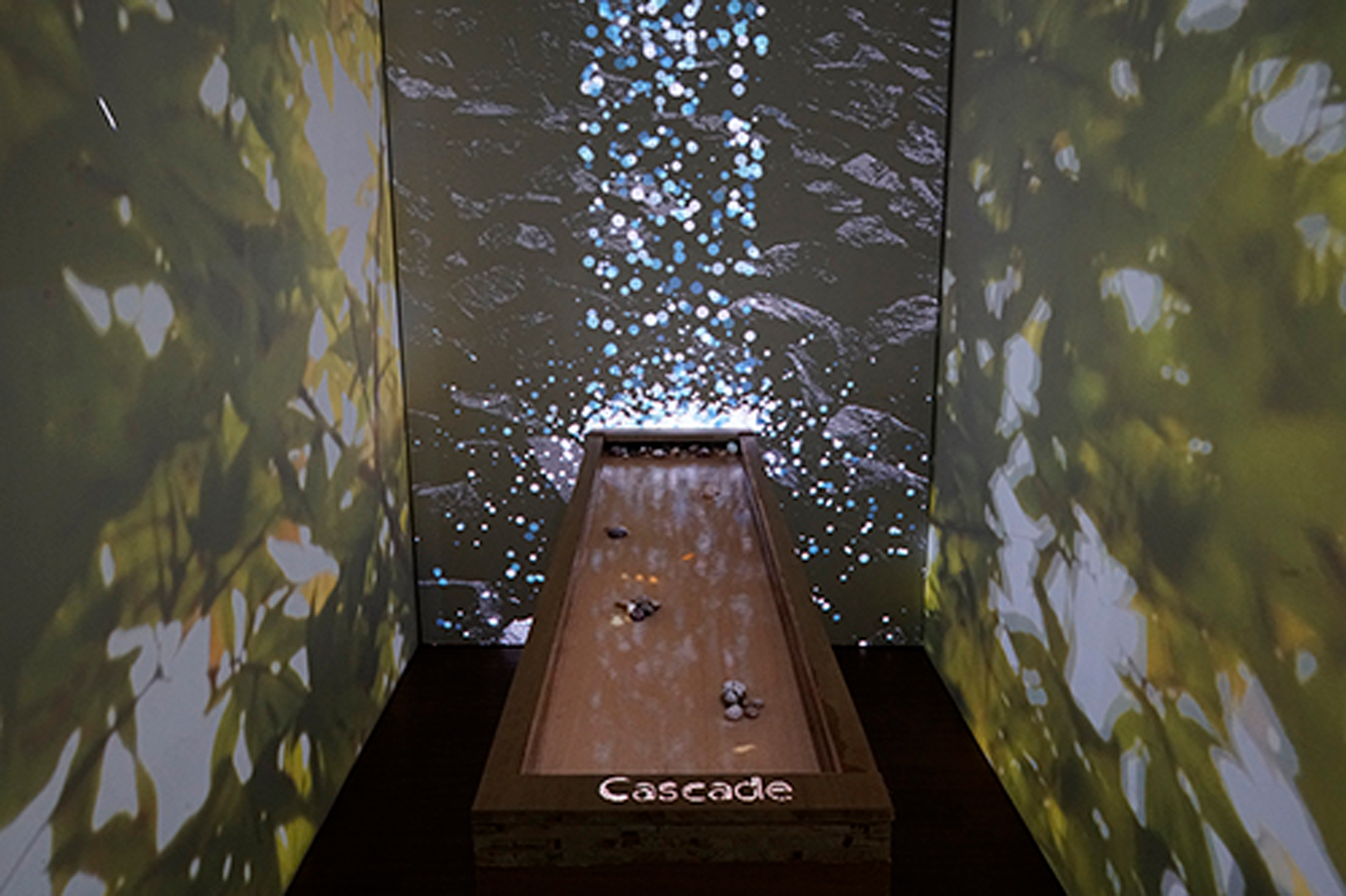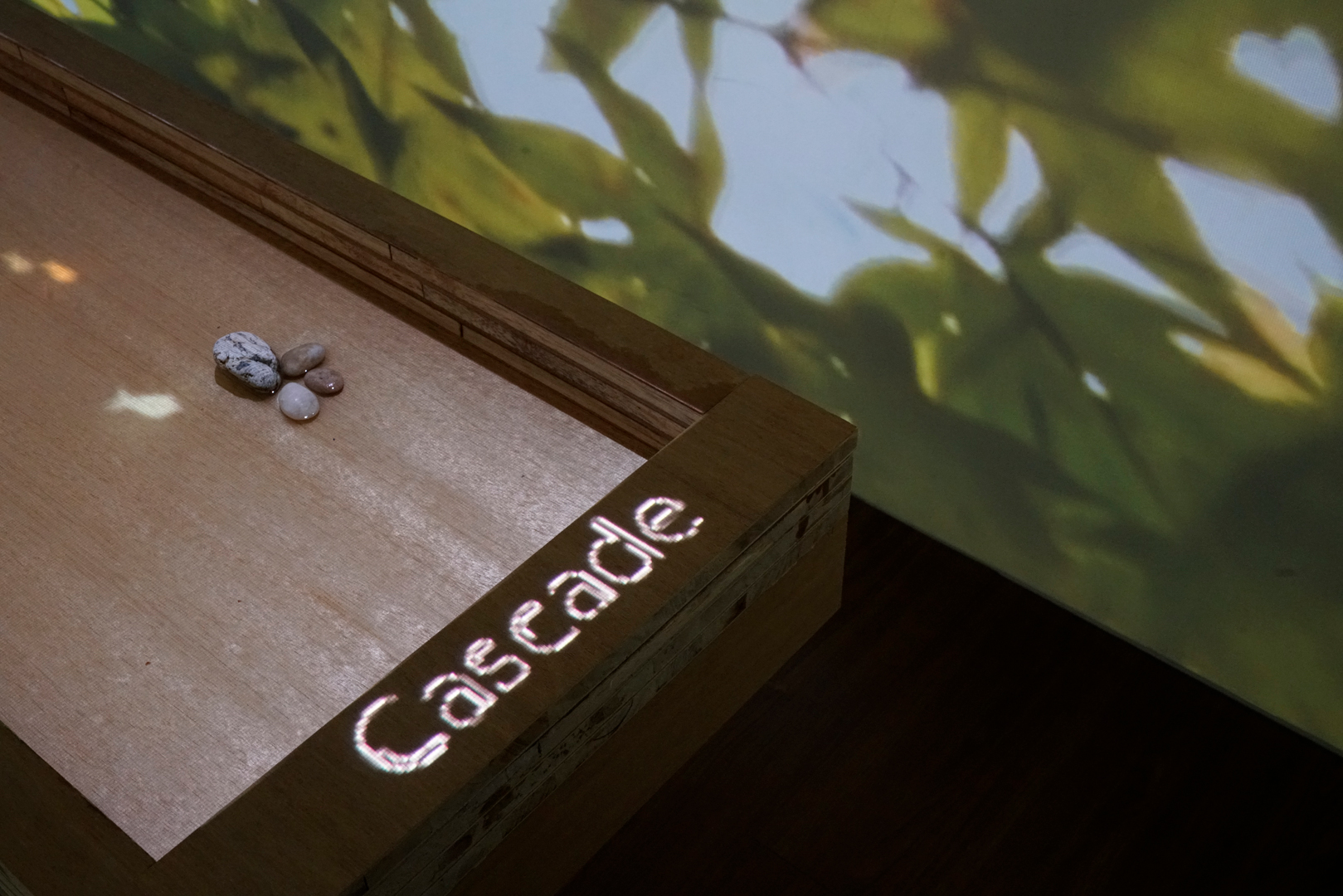Long Hin Porsche Cheng, Yuet Ting Cheng: Cascade
Artist(s):
Title:
- Cascade
Exhibition:
Category:
Artist Statement:
Summary
Cascade is an interactive digital installation which provides an immersive experience of user-interaction with flowing water and pebbles. Based on human interactions, virtual projections of a cascade and a shoal of fish are effected.
Abstract
The physical part of the installation composes of two major elements, namely a wooden table and a water ecosystem. The table is served as a water reservoir as well as an interaction interface while the water ecosystem provides a non-stop water flow for the water reservoir.
In my home country, Hong Kong, plants are commonly found on external walls of newly-established buildings upon the emerging idea of urban oasis in metropolitan city. With the old saying, “Water is Life”, water plays an essential role in our life. The question comes: Why are there only plants, but not water, found in newly-constructed buildings?
Cascade is therefore set up with the following five objectives:
1. To inject elements of nature in a concrete jungle to show respect for nature
2. To involve audience taking part in the creation of artwork
3. To immerse in the nature-like environment to feel relaxed
4. To interact with virtual projection and water in real life
5. To integrate skills and knowledge learnt in my student life
With the use of sensor technology and interactive projection mappings, this artwork brings a cascade and a water reservoir from the rural nature to the urban city. Audience are therefore able to experience the artwork and immerse into the nature with tactile feeling but without geographical and time limits. Projections are not pre-recorded clips but are lively rendered by a software program encompassing the theme of ‘Post-Algorithm: Art and life in the age of Artificial Intelligence.’
Technical Information:
On the technical side, the installation is set up with multimedia system consisting of a Mac Pro computer, four projectors, a speaker, a network router, an Xbox Kinect Sensor and an Arduino board. The Arduino board is connected to five relays, two ultrasonic sensors, one infra-red sensor, one water-flow sensor and one water-level sensor for detections and signal transmissions. There are three major interactions in Cascade.
First, when audience enter the room, the infra-red sensor senses his movement and turns off the table lighting. Projection of a cascade then fades in with music triggering the water ecosystem to be turned on to form a water reservoir.
Second, projection reminds audience to open the under-table drawer and interact with pebbles. When users open the drawer, the ultrasonic sensor senses the drawer movement and turns the LED on/off.
Third, when users place pebbles on the table, water volume and flow rate of the reservoir will be changed. Therefore, the water-level sensor is used to detect the amount of water for controlling the water overflow and the water-flow sensor is used to transmit serial signals for projections of swimming fish to be mapped onto the reservoir accordingly. Pebbles are detected by the Xbox sensor to avoid fish collisions.
Process Information:
Cascade is an interactive digital installation which provides an immersive experience of user-interaction with flowing water and pebbles. Integrating flowing water and interactive projections into a single piece is the most distinguishable and representable part of Cascade.
With the use of sensor technology and interactive projection mappings, this artwork brings a cascade and a water reservoir from the rural nature to the urban city. I hope that not only will the audience interact with the artwork, but they will also rethink about the meaning of water through participating in an immersive journey in the city centre.
Back to the pre-production stage of Cascade, I planned to build the installation in my university where space and tools are sufficient and easily accessible. However, due to COVID-19, I was not able to access the production workshop and the production progress was hence delayed.
After few weeks of struggling, I decided to relocate the production to a mini studio in an industrial building in Hong Kong. The size of the mini studio was unexpectedly matched with my installation settings while the projection outcome also facilitated the setup of an immersive environment. Once entering the mini studio, the audience will be surrounded by projections on three walls and guided to interact with the installation. I was satisfied when I encountered all the challenges.
Other Information:
Inspiration Behind the Project
The idea of Cascade is inspired by a singing concert which made use of water to symbolise reincarnation. While the concept of water was represented by dancing, melodies and lyrics, I wondered if flowing water can be injected with an installation of interactive projections.
Water, to me, means stillness, flexibility and potentiality. Through immersing into an environment and interacting with visuals, sounds and tactile sensation, I wish Cascade can enrich the meaning of water and inspire visitors like how the concert inspired me.






